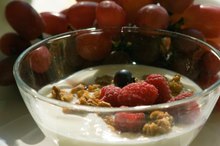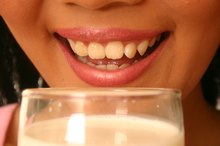What does fact checked mean?
At Healthfully, we strive to deliver objective content that is accurate and up-to-date. Our team periodically reviews articles in order to ensure content quality. The sources cited below consist of evidence from peer-reviewed journals, prominent medical organizations, academic associations, and government data.
- Office of Dietary Supplements; Vitamin D; February 2011
- MedlinePlus: Calcium
- Linus Pauling Institute; Phosphorous; Jane Higdon; April 2003
The information contained on this site is for informational purposes only, and should not be used as a substitute for the advice of a professional health care provider. Please check with the appropriate physician regarding health questions and concerns. Although we strive to deliver accurate and up-to-date information, no guarantee to that effect is made.
Rickets is a disease characterized by soft, weak bones in children. The symptoms of rickets include pain and tenderness in the bones, especially in spine, arms, pelvis and legs; slow growth and/or short height; muscle cramps; and abnormal teeth. Rickets is caused by a deficiency in at least one of three essential nutrients: vitamin D, calcium or phosphorous. Therefore, a diet to reverse rickets needs to contain foods rich in at least one of these nutrients.
Foods Rich in Vitamin D
Getting enough vitamin D supports strong bones and can prevent rickets. When ultraviolet rays from the sun hit the skin, the result is synthesis of vitamin D. However, children with very dark skin or who do not get enough sun exposure are susceptible to a vitamin D deficiency and therefore rickets. Eating foods rich in vitamin D can supply all the vitamin D to support strong bones. Good dietary sources of vitamin D include:
- cod liver oil
- salmon
- mackerel
- tuna
- eggs
- yogurt 1
Many foods have also been fortified with vitamin D, such as orange juice, milk, margarine and breakfast cereals.
- Getting enough vitamin D supports strong bones and can prevent rickets.
- When ultraviolet rays from the sun hit the skin, the result is synthesis of vitamin D. However, children with very dark skin or who do not get enough sun exposure are susceptible to a vitamin D deficiency and therefore rickets.
Foods Rich in Calcium
5 Common Vitamin Deficiencies Linked to Chapped Lips
Learn More
A diet for rickets should also contain foods rich in the essential mineral calcium. More than 99 percent of calcium in the body accumulates in the bones, and this mineral is necessary in conjunction with vitamin D and phosphorous to prevent rickets. Foods rich in calcium are dairy-based foods such as milk, yogurt and cheese; leafy green vegetables like kale and spinach also contain a good amount of calcium.
- A diet for rickets should also contain foods rich in the essential mineral calcium.
- More than 99 percent of calcium in the body accumulates in the bones, and this mineral is necessary in conjunction with vitamin D and phosphorous to prevent rickets.
Foods Rich in Phosphorous
Because phosphorous is necessary for strong bones, a rickets diet should also contain foods that provide essential mineral. Good dietary sources of phosphorous include some of the same foods that are rich in calcium: diary-based foods like milk, cheese and yogurt; eggs; and salmon. Other foods that contain phosphorous are whole-wheat and enriched bread; halibut, beef, chicken and turkey; and cola.
The Importance of Milk
Can Foods Make You Grow Taller?
Learn More
Fortified milk is a beneficial addition to a rickets diet because it contains vitamin D, calcium and phosphorous. However, some people do not drink milk for one or more reasons, such as not liking milk, avoiding animal-based foods in general or being lactose intolerant. For these children, it is important that their rickets diet contain several of the other foods rich in vitamin D, calcium and/or phosphorous.
Vegetarian Diets
A vegetarian diet may lack the essential nutrients necessary to support strong bones and may lead to rickets. Eating fortified foods or taking vitamin supplements can prevent nutrient deficiencies to which vegetarians are susceptible.
Related Articles
References
- Office of Dietary Supplements; Vitamin D; February 2011
- MedlinePlus: Calcium
- Linus Pauling Institute; Phosphorous; Jane Higdon; April 2003
- Craviari T, Pettifor JM, Thacher TD, et al. Rickets: an overview and future directions, with special reference to Bangladesh. A summary of the Rickets Convergence Group meeting, Dhaka, 26-27 January 2006. J Health Popul Nutr. 2008;26(1):112-121.
- Trautvetter U, Ditscheid B, Jahreis G, Glei M. Calcium and phosphate metabolism, blood lipids and intestinal sterols in human intervention studies using different sources of phosphate as supplements-pooled results and literature search. Nutrients. 2018;10(7):936. doi:10.3390/nu10070936
- O'Riordan JL, Bijvoet OL. Rickets before the discovery of vitamin D. Bonekey Rep. 2014;3:478. doi:10.1038/bonekey.2013.212
- Genetics Home Reference. Hereditary hypophosphatemic rickets. Updated August 17, 2020.
- Shikino K, Ikusaka M, Yamashita T. Vitamin D-deficient osteomalacia due to excessive self-restrictions for atopic dermatitis. BMJ Case Rep. 2014;2014:bcr2014204558. doi:10.1136/bcr-2014-204558
- National Health Service. Rickets and osteomalacia—symptoms.
- Pettifor JM. Rickets. Calcif Tissue Int. 2002;70(5):398-399.
- National Health Service. How to get vitamin D from sunlight. Updated August 21, 2018.
- Office of Dietary Supplements. Vitamin D. Updated September 11, 2020.
- Nair R, Maseeh A. Vitamin D: The "sunshine" vitamin. J Pharmacol Pharmacother. 2012;3(2):118-126. doi:10.4103/0976-500X.95506
- National Organization for Rare Disorders. Familial hypophosphatemia. Updated 2019.
- Imel EA, Glorieux FH, Whyte MP, et.al. Burosumab versus conventional therapy in children with X-linked hypophosphataemia: a randomised, active-controlled, open-label, phase 3 trial. Lancet. 2019 Jun 15;393(10189):2416-2427. doi:10.1016/S0140-6736(19)30654-3
- Sahay M, Sahay R. Rickets-vitamin D deficiency and dependency. Indian J Endocrinol Metab. 2012;16(2):164-176. doi:10.4103/2230-8210.93732
Writer Bio
Leah DiPlacido, a medical writer with more than nine years of biomedical writing experience, received her doctorate in immunology from Yale University. Her work is published in "Journal of Immunology," "Arthritis and Rheumatism" and "Journal of Experimental Medicine." She writes about disease for doctors, scientists and the general public.









